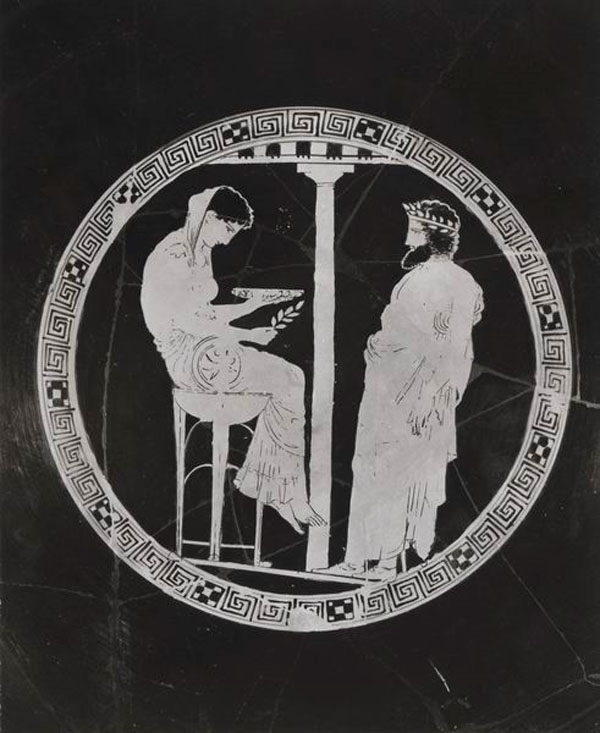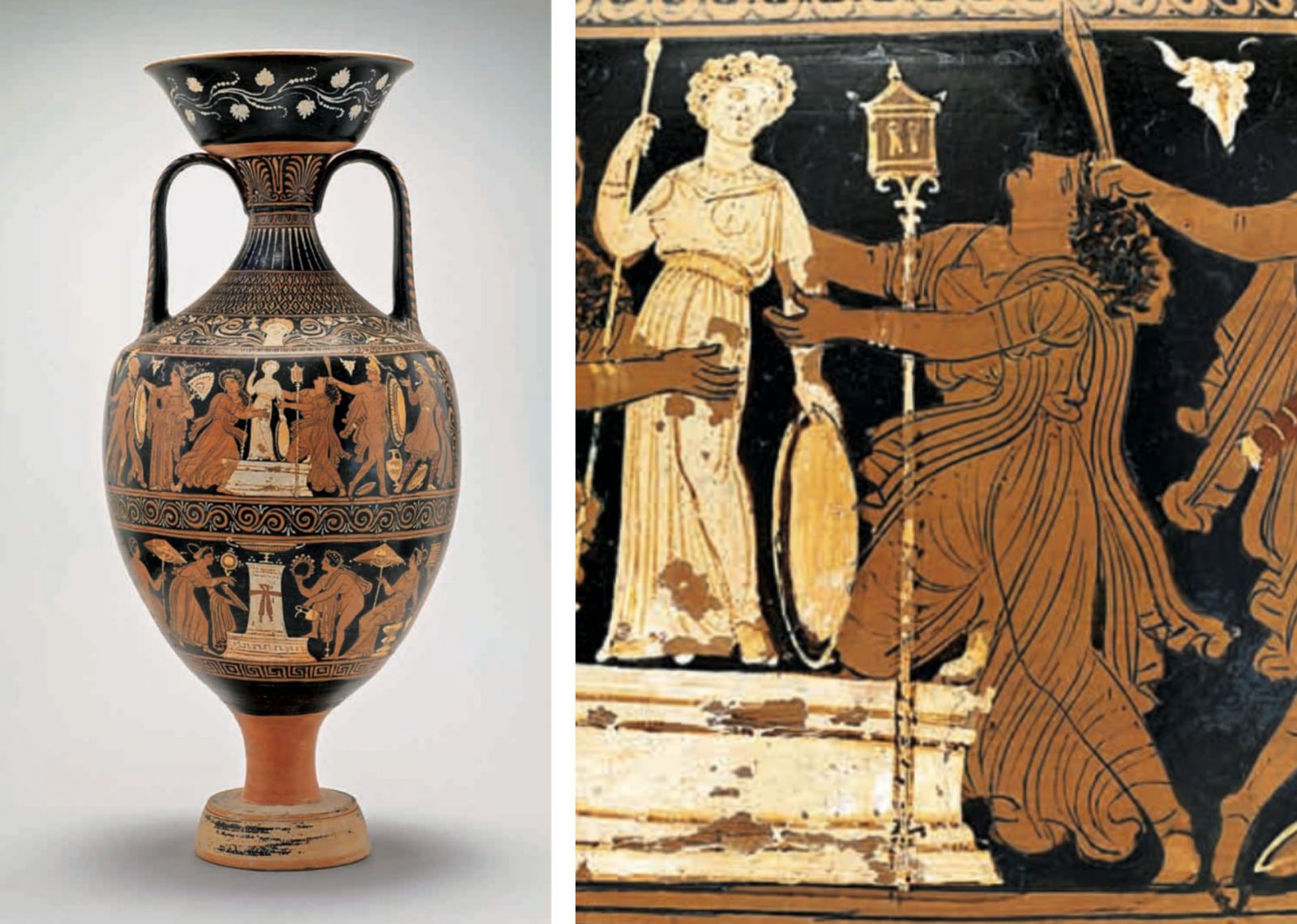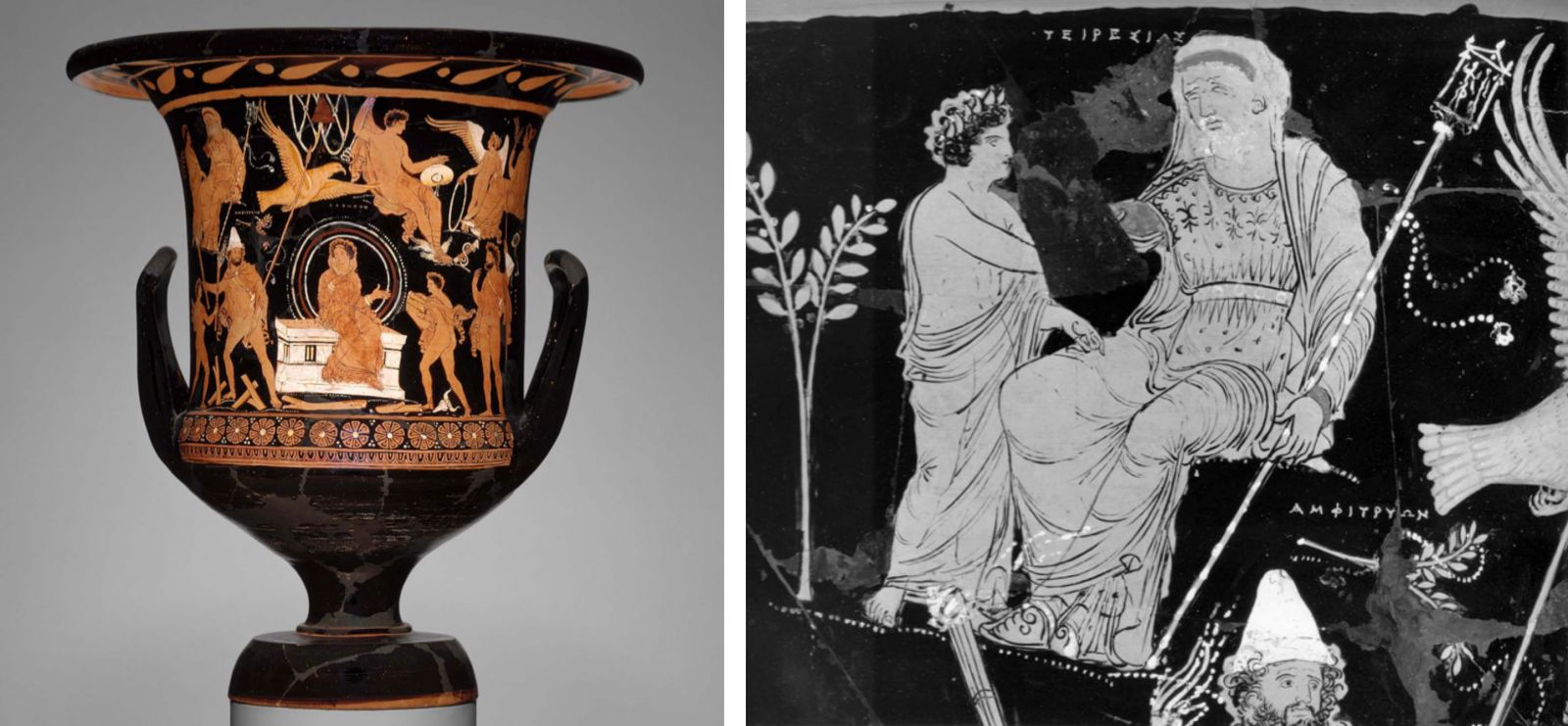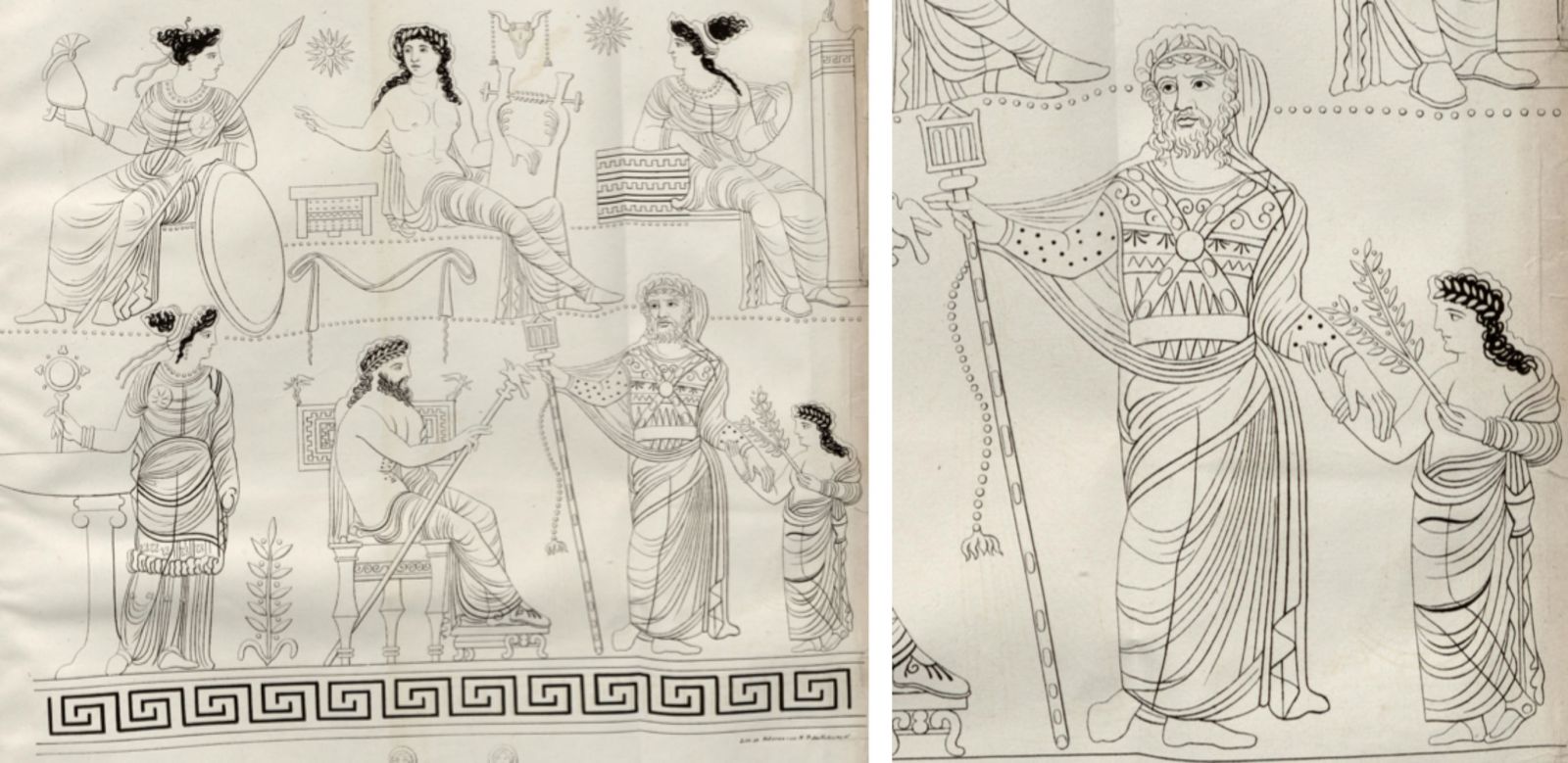Torn Fillets and a Broken Sceptre: Cassandra’s Costume, Props and Attributes in Ancient Greek Drama and Vase-Painting
Fabio Lo Piparo
Abstract
Cassandra stands out as one of the best examples of the long lasting role played in the Western cultural tradition by figures drawn from Classical antiquity. This essay analyses the strategies employed for the visual representation of Cassandra as a fictional character from two particular perspectives that deal with her physical appearance, providing her with an iconography that represents her in the figurative arts and theatrical productions.
Both literary and figurative sources deliver the main lines of her myth: Cassandra is a Trojan princess, the fair daughter of King Priam assaulted by the Locrian Ajax during the sack of Troy, promised as a war prisoner, slave and concubine to King Agamemnon, and eventually murdered together with him by the King’s wife Clytemnestra [see e.g. Mason 1959, Mazzoldi 2001, Paoletti 1994].
Nowadays, however, Cassandra is quintessentially known as a cursed prophetess: this main trait is related to her status of clairvoyant and priestess of Apollo, the god who gifted her with prophetic wisdom and eventually cursed her, after having been betrayed, so that her true prophecies would not be trusted by anyone.
As far as we know from extant sources, Greek epic and lyric poetry mention sporadically the mantic role of Cassandra, i.e. when she foresees the catastrophic outcome of Paris’ journey to Greece, or when she tries to dissuade the Trojans from welcoming the wooden horse within the city gates. This specific feature is fully developed only after the emergence of drama in 5th century Athens onwards.
Attic tragedy, both in complete and in fragmentary dramas, portrays Cassandra constantly and explicitly as a prophetess. This seems to occur even when the focus on other aspects of the character are privileged, as in the case of Sophocles’ lost Ajax Locreus, set around the effects of the hero’s violence upon Cassandra. According to some reconstructions of the plot, Ajax’s death would have been prefigured at the very end of the tragedy by Cassandra – i.e. she is outlined as a prophetess and not just as a virgin, victim or suppliant [see e.g. Fitzpatrick 2003; on the iconographic treatment of the assault at the feet of Athena's statue see, more recently, Tzachou-Alexandre 2014].
The lack of chronological data for the fragmentary tragedies featuring Cassandra leads to consider Aeschylus’ Oresteia as a starting point, his portrait of Cassandra in the Agamemnon being the first, innovative theatrical appearance of the character as a prophetess.
The clairvoyant shows knowledge of the violent past of the House of Atreus; she foresees Agamemnon’s and her own imminent deaths at the hands of Clytemnestra; and tells the Elders the episode of her physical – not yet sexual – encounter with Apollo, giving the first and most detailed account of her betrayal, a story to be considered in all likelihood a truly Aeschylean invention, or at least a less attested version, whose authority the dramatist wanted to enhance.
What does Cassandra look like in the Agamemnon? A textual focus onto Cassandra’s costume and stage properties is related to one of the most pathetic moments in the play. Just before processing through the doors into Agamemnon’s palace, Cassandra deliberately frees herself of the visual evidence of Apollo’s curse; she breaks and casts away her sceptre, and strips and tearsoff her priestly fillets, violently throwing all her paraphernalia onto the floor:
ΚΑΣΣΑΝΔΡΑ
τί δῆτ᾿ ἐμαυτῆς καταγέλωτ᾿ ἔχω τάδε
καὶ σκῆπτρα καὶ μαντεία περὶ δέρῃ στέφη;
σὲ μὲν πρὸ μοίρας τῆς ἐμῆς διαφθερῶ·
ἴτ᾿ ἐς φθόρον· πεσόντα γ᾿ ὧδ᾿ ἀμείβομαι·
ἄλλην τιν᾿ ἄτης ἀντ᾿ ἐμοῦ πλουτίζετε.
ἰδοὺ δ᾿, Ἀπόλλων αὐτὸς οὑκδύων ἐμὲ
χρηστηρίαν ἐσθῆτ᾿. ἐποπτεύσας δέ με
κἀν τοῖσδε κόσμοις καταγελωμένην μέγα
φίλων ὑπ᾿ἐχθρῶν οὐ διχορρόπως, μάτην
ἀλωμένη δέ, φοιτὰς ὡς ἀγύρτρια,
πτωχὸς τάλαινα λιμοθνὴς ἠνεσχόμην.
“Cassandra: [Shaking out her prophetic robe] Why, then, have I got this gear on to mock me, and this staff, and the prophetic bands about my neck? I’ll destroy you before meeting my own fate! [She breaks her staff and throws the pieces to the ground.] Go to perdition [throwing off her neck-bands] - now you’re on the ground, this is how I get my own back on you [trampling on them]! Make some other woman rich with ruin, instead of me! [As she tears off her robe] Look, it is Apollo himself who is stripping me of my prophetic garb. He looked on when I, wearing all these accoutrements, was being roundly and unanimously mocked by friends who acted like enemies in vain, I endured having to wander like an itinerant begging priestess, a wretched, starving pauper”.
Aesch., Ag. 1263-1264 [ed. and trans. Sommerstein 2009]
Her rejection of the sceptre and priestly fillets signify Cassandra’s ultimate repudiation of Apollo’s sacral consecration and divine gift of prophecy, gifts perverted by the god causing his victim to be mocked and derided. These concepts are reminiscent of two specific Apollonian attributes that go back to earliest epic traditions. In the opening scene of the Iliad, Chrises, the priest of Apollo, holds a sceptre with fillets marking the god’s powerful presence by his side, while reclaims her daughter, Agamemnon’s slave:
[…] ὁ γὰρ ἦλθε θοὰς ἐπὶ νῆας Ἀχαιῶν
λυσόμενός τε θύγατρα φέρων τ᾿ ἀπερείσι᾿ ἄποινα,
στέμματ᾿ ἔχων ἐν χερσὶν ἑκηβόλου Ἀπόλλωνος
χρυσέῳ ἀνὰ σκήπτρῳ, […]
ἀλλ᾿ οὐκ Ἀτρεΐδῃ Ἀγαμέμνονι ἥνδανε θυμῷ,
ἀλλὰ κακῶς ἀφίει, κρατερὸν δ᾿ ἐπὶ μῦθον ἔτελλε·
“μή σε, γέρον, κοίλῃσιν ἐγὼ παρὰ νηυσὶ κιχείω
ἢ νῦν δηθύνοντ᾿ ἢ ὕστερον αὖτις ἰόντα,
μή νύ τοι οὐ χραίσμῃ σκῆπτρον καὶ στέμμα θεοῖο.
“For he [scil. Chryses] had come to the swift ships of the Achaeans to free his daughter and he brought with him ransom past counting; and in his hands he held the ribbons of Apollo, who strikes from afar, on a staff of gold, … yet this did not please the heart of Agamemnon, son of Atreus, but he sent him away harshly, and laid on him a stern command: «Let me not find you, old man, by the hollow ships, either loitering now or coming back later, for fear your staff and the god’s ribbon not protect you»”.
Ilias 1.11-28 [ed. and trans. Murray 1924]
Scholars, editors and commentators [see e.g. Fraenkel 1950, ad loc.; Matteuzzi 2008] have suggested that there are similarities between Cassandra’s oracular garb and the agrenon, a net-like garment worn by priests and prophets – like Tiresias, as mentioned by Pollux in his list of tragic costumes – and the comparable woollen, knotted cover of the Delphic omphalos. Cassandra – partially merged, via the agrenon, with the Apollinean priestess par excellence, the Pythia – is portrayed as a prophetic priestess.
The peculiar power of Cassandra’s scene in the Agamemnon is recalled and evoked by Euripides in his Trojan Women, forty-three years after the first performance of the Oresteia. Here Hecuba, informed by Talthybius of Cassandra’s future at Agamemnon's side, invites her daughter (still offstage) to throw away the laurel branches – yet another strong Delphic attribute – and the sacred fillets that encircle her body:
ΕΚΑΒΗ
τοὐμὸν <μὲν> τίς ἆρ᾿ ἔλαχε τέκος, ἔνεπε,
τλάμονα Κασσάνδραν;
ΤΑΛΘΥΒΙΟΣ
ἐξαίρετόν νιν ἔλαβεν Ἀγαμέμνων ἄναξ.
[…]
ΕΚΑΒΗ
ῥῖπτε, τέκνον, ζαθέους κλά-
δας καὶ ἀπὸ χροὸς ἐνδυ-
τῶν στεφέων ἱεροὺς στολμούς.
“Hecuba: Tell me, who has won my daughter, Cassandra the unblest? | Talthybius: King Agamemnon took her as his special prize. | … | Hecuba: Cast away, my child, your holy laurel branches, and from your body strip the sacred garlands you wear!”
Eur., Tr. 247-258 [ed. and trans. Kovacs 1999]
Later Cassandra, featured in a mantic as well as frenzied and maenadic attitude, follows her mother’s advice, loosing her priestly garb and abandoning onstage as it will soon become inappropriate to her future role of slave and concubine – no longer a virgin, pure no more. The dramatic tones of this farewell are almost romantic and nostalgic, and have nothing to do with the anger or the hostility that mark the same gesture in Aeschylus' play:
ΚΑΣΣΑΝΔΡΑ
ὦ στέφη τοῦ φιλτάτου μοι θεῶν, ἀγάλματ᾿ εὔια,
χαίρετ᾿· ἐκλέλοιφ᾿ ἑορτάς, αἷς πάροιθ᾿ ἠγαλλόμην.
ἴτ᾿ ἀπ᾿ ἐμοῦ χρωτὸς σπαραγμοῖς, ὡς ἔτ᾿ οὖσ᾿ ἁγνὴ χρόα
δῶ θοαῖς αὔραις φέρεσθαί σοι τάδ᾿, ὦ μαντεῖ᾿ ἄναξ.
“Cassandra: O garlands that belong to the god I love best, finery of divine inspiration, farewell! (She throws her sacred emblems on the ground.) I have left behind the festivals in which I once used to exult. Depart from my flesh as I tear you away, so that while I am still pure in body I may give you to the swift winds to carry to you, my prophetic lord!”
Tr. 451-454 [ed. and trans. Kovacs 1999]
Passages referreing to Cassandra in other Euripidean tragedies, as well as fragments from lost dramas that portray her, highlight the relationship between Cassandra and the Pythia, a connection one can tentatively suggest by considering her Aeschylean costume as an agrenon. In his Andromache and Iphigenia at Aulis, the poet presents the prophetess in strictly Delphic attire, sporting again the Apollonean laurel in form of branches and garlands:
ΧΟΡΟΣ
εἰ γὰρ ὑπὲρ κεφαλὰν ἔβαλεν κακὸν
ἁ τεκοῦσά νιν μόρον
πρὶν Ἰδαῖον κατοικίσαι λέπας,
ὅτε νιν παρὰ θεσπεσίῳ δάφνᾳ
βόασε Κασσάνδρα κτανεῖν,
μεγάλαν Πριάμου πόλεως λώβαν. τίν᾿ οὐκ ἐπῆλθε,
ποῖον οὐκ ἐλίσσετο
δαμογερόντων βρέφος φονεύειν;
“Chorus: Would that the mother who bore him had cast him over her head to an evil end before he came to dwell on a ridge of Ida! Beside the prophetic laurel Cassandra shrieked, bidding her kill the child, great destroyer of Priam’s city. Whom did she not approach, which of the city’s elders did she not beg to kill the child?”
[Eur., And. 293-300 [ed. and trans. Kovacs 1995]
ΧΟΡΟΣ
ἥξει δὴ Σιμόεντα καὶ
δίνας ἀργυροειδεῖς
ἄγυρις Ἑλλάνων στρατιᾶς
ἀνά τε ναυσὶν καὶ σὺν ὅπλοις
Ἰλίου ἐς πετραίας
Φοιβήιον δάπεδον,
τὰν Κασσάνδραν ἵν᾿ ἀκούω
ῥίπτειν ξανθοὺς πλοκάμους
χλωροκόμῳ στεφάνῳ δάφνας
κοσμηθεῖσαν, ὅταν θεοῦ
μαντόσυνοι πνεύσωσ᾿ ἀνάγκαι.
“Chorus: They will come to the Simois and its silvery eddies, the whole assemblage of the Greek army, and on their ships with spear in hand they will reach the Phoebus-built land of rocky Ilium. There, I am told, Cassandra tosses her yellow hair, adorned with the green crown of myrtle [lit. of laurel] when she is controlled by the god’s prophetic inspiration”.
[Eur., IA 751-761[ed. and trans. Kovacs 2003]
Cassandra’s sceptre, however, remains an exclusive Aeschylean mark.
With regard to the iconographic treatment of Cassandra, what follows is a brief gallery of selected Attic and South-Italian artefacts from the second half of 5th century BC onwards, that focus on the incidence of specific mantic attributes, useful to better understand the functions fulfilled by the character, and to gain insights into the resonances that drama had on the visual arts.

1 | Attic red figured cup, attr. Marlay Painter, 450-400 BC (Ferrara, Museo Nazionale di Spina 2482 – T 264).

2 | 'Themis Cup', attr. Codrus Painter, 450-400 BC (Berlin, Antikensammlung F 3538).
The central medallion of an Attic red figured cup attributed to the Marlay Painter (450-400 BC, Ferrara, Museo Nazionale di Spina 2482 – T 264 = LIMC Kassandra I 202) (fig. 1) depicts the imminent death of Cassandra, positioned next to an altar, and about to be slaughtered by Clytemnestra with an axe [for another, possible depiction of this scene, see Bouzek 2012]. With no labels or inscription, two elements in the “scenography” help to understand the scene and to name victim and assailant. The falling tripod – remarking, together with the altar, the perverted and corrupted “sacrifice” of the woman – and a laurel tree are comparable with the usual Delphic motives and settings, as seen e.g. in the depiction of the oracular consultation in the Themis Cup by the Codrus Painter (450-400 BC, Berlin, Antikensammlung F 3538 = LIMC Themis 10) (fig. 2), chronologically and stylistically related to the Ferrara Cup. However, there are no attributes that pertain specifically to Cassandra.
This trend – recognizable also in the sparse coroplastic tradition related to the character [see Chamay 2015] – is significantly reversed in South-Italian vase-painting, with examples revolving around three principal figures and workshops of Apulian production; the Darius Painter, one of his predecessors (and teachers?), the De Schulthess Painter, and two of his direct/indirect followers and continuators; the Underworld Painter; and the Baltimore Painter, between Taras and Canosa in the second half of the 4th century BC.

3-4 | Apulian Volute Krater, attr. De Schultess Painter, 350-300 BC (Geneve, Coll. Hellas et Roma).
A Volute Krater ascribed to the De Schultess Painter (Geneve, Coll. Hellas et Roma) (figs. 3-4) showing the arrival of Paris and Helen in Troy – the subject of lost Attic dramas such as Sophocles’ Phrygians [see e.g. Pearson 1917:326-327]– portrays, on the upper register, a seated, sobbing Cassandra with a laurel wreath and a knotted and tasselled fillet around her head, holding two laurel branches encircled with similar fillets – one has just fell off from her left hand – and a net-like outer garment made of fillets attached to her leg. This image is the only extant depiction of Cassandra wearing an agrenon [see Roscino 2008]. Moreover, the laurel branch pointing towards the ship bringing Paris and Helen to Troy, depicted in the lower register, could suggest that the attribute assigned to her serves as an iconographic device, translating into image the specific subject of Cassandra’s prophecy.

5-6 | Apulian Volute Krater, attr. Underworld Painter, 350-300 BC (Berlin, Staatliche Museen 1984.45).
A similar function for Cassandra’s laurel branches can be found on a Volute Krater ascribed to the Underworld Painter (Berlin, Staatliche Museen 1984.45 = LIMC Kassandra I 32) (figs. 5-6), showing the departure of Hector for the Trojan battlefield – a depiction related to Astydamas’ lost Hector [see Taplin 2007:253-256]. On the upper register, Cassandra leans in despair against her mother Hecuba; she wears a laurel wreath and holds upside-down a wrapped branch with her left hand, two attributes shared with her twin brother Helenus. Next to the woman, a filleted tripod standing on the top of an Ionic column confirms her prophetic and Apollonian characterization. The branch points to Hector’s helmet, held by a charioteer, in the lower register, part of the Homeric legacy put into drama and relived by Astydamas.

7 | Apulian Volute Krater, attr. Darius Painter (Geneve, private collection).

8 | Ajax grasps Cassandra’s hair and drags her away from Athena’s statue (detail of the Apulian Volute Krater, attr. Darius Painter, 350-300 BC, Geneve, private collection).
Laurel occurs together with a new, original attribute for Cassandra as depicted onto a fragmentary Volute Krater by the Darius Painter (Geneve, private collection = LIMC Suppl. 2009 Ilioupersis add. 1) (figs. 7-8). The large vessel displays scenes from the Ilioupersis. Ajax grasps Cassandra’s hair and drags her away from the statue of Athena she is clinging to. Athena’s priestess, Theano – holding a filleted temple key – tries to hinder the aggression. A laurel branch fills the space between Cassandra and Theano. A falling sceptre is painted across the victim’s body, between the woman and her assailant: the shaft is dotted in white, its termination is shaped as a naiskos, its pediment culminating with acroteria and two figures – their details carefully rendered in polychromy – within its frame. Traces of a knotted and tasselled fillet between Ajax’s legs are possibly related to the sceptre.
Both this attribute and the laurel branch are not indispensable to understand a scene whose modular scheme and characters represent one of the most frequent and recognizable patterns from – at least – Attic black figured vase painting onwards. Whilst branches could be intended as an ornamental motive, quite common in Apulian vase painting, the naiskos sceptre constitutes a truly innovative attribute, scarcely attested as exclusive to Cassandra and few others characters related to her prophetic role.
Surprisingly, scholars have drawn no attention to the naiskos sceptre, and its interpretation remains still vague and uncertain. Its peculiar termination seems to replicate the naiskoi well attested in South-Italian vase painting, appearing at the same time as miniaturized copies of the funerary shrines which encircled the deaths. New, further insights into this iconographic detail are therefore needed.

9 | Apulian Fragmentary Amphora, attr. Darius Painter, 350-300 BC (Halle 215).
Cassandra’s prop in Geneve Ilioupersis is useful to attempt a virtual restoration of another work by the Darius Painter, a fragmentary Amphora (Halle 215) (fig. 9). Here a portion of fallen shaft, its termination unfortunately missing, crosses Cassandra's right foot as she is attacked by Ajax.

10-11 | Apulian Amphora, attr. Baltimore Painter, 350-300 BC (Avignon, Musée Calvet 2001.4, ex Melbourne, Geddes Collection A:5:2).
Four pieces ascribed to the Baltimore Painter, two Amphorae – (Avignon, Musée Calvet 2001.4, ex Melbourne, Geddes Collection A:5:2 = LIMC Kassandra I 141) (figs. 10-11); (Basel, Antikenmuseum BS 1456 = LIMC Suppl. 2009 Ilioupersis add. 3a) (figs. 12-13) – and two Volute Kraters – (Zurich, Galérie Nefer = LIMC Kassandra I 137) (figs. 14-15); (Basel, Antikenmuseum BS 1457 = LIMC Suppl. 2009 Ilioupersis add. 3b) (figg. 16-17) – depict the mirrored assault to Helen and Cassandra by Menelaus and Ajax. The composition process by means of juxtaposing and replicating sections emerges straightforward, despite slight variations and differences, for Ajax and Cassandra’s blocks: four variations drawn out from the same iconographic model. Cassandra’s sceptre adorned by phytomorphic tip stands upright, encircled by her arms; the Basel Krater, again, depicts a knotted and tasselled fillet hangs from the shaft.

12-13 | Apulian Amphora, attr. Baltimore Painter, 350-300 BC (Basel, Antikenmuseum BS 1456).

14-15 | Apulian Volute Krater, attr. Baltimore Painter, 350-300 BC (Zurich, Galérie Nefer).

16-17 | Apulian Volute Krater, attr. Baltimore Painter, 350-300 BC (Basel, Antikenmuseum BS 1457).

18 | Apulian Dinos, attr. Manner of the Darius Painter, 350-300 BC (London, antiquarian market).
The five – perhaps six – vases featuring Cassandra’s sceptre are significantly prominent to justify assigning it as one of her specific attributes. The few others occurrences of the naiskos sceptre in Apulian vase painting assure its strong relationship with the mantic domain: it is attested for Apollo (together with a filleted laurel branch and two tripods) and Dionysus – gods who both exercise their influence upon Cassandra’s prophetic behaviour in Euripides – on two twin dinoi ascribed to the Manner of the Darius Painter (London, antiquarian market = RVAp Suppl. I 80/106a; 106b) (figs. 18-19).

19 | Apulian Dinos, attr. Manner of the Darius Painter, 350-300 BC (London, antiquarian market).

20-21 | Apulian Calyx Krater, attr. Darius Painter, 350-300 BC (Boston, Museum of Fine Arts 1989.100).
A filleted naiskos sceptre, again, completes Teiresias’ outfit on a Calyx Krater by the Darius Painter showing Alkmene’s apotheosis, possibly related to Euripides’ homonymous tragedy [see Taplin 2007:172-174] (Boston, Museum of Fine Arts 1989.100 = LIMC Teiresias 4) (figs. 20-21).

22-23 | 19th century drawing of a lost Apulian vase.
This evidence justify identifying the prophet as a member of the embassy depicted on a lost Apulian vase known for 19th century drawings (figg. 22-23). Séchan associates the scene with to Sophocles’ Oedipus Rex [Séchan 1926:143-145], rejecting previous interpretations that read the image as the confrontation between King Agamemnon and the priest of Apollo, Chrises, the Homeric precedent for Cassandra’s role in Aeschylus’ Agamemnon.

24 | Fragment of Pestan Calyx Krater, attr. Assteas, 330 BC ca. (Rome, Museo di Villa Giulia, 50.279).
In the light of what has been said above, the circumstances which prevent us to fully understand the treatment of costumes and “stage props” in the gender-swapped parody of the Rape of Cassandra in the Pestan Calyx Krater shard ascribed to Assteas (330 BC ca., Rome, Museo di Villa Giulia 50.279 = LIMC Kassandra I 154) [fig. 24], probably related to a comic version of a tragic model – perhaps the Sophoclean Ajax Locreus? – are even more unfortunate.
To conclude, the attributes given to Cassandra by Apulian painters underline her status and function as a priestess of Apollo and a prophetess even in cases where they are unnecessary for her identification, where different aspects of the character – i.e. that of a harmless woman – are required or expected as sufficient: this trend appears to be significantly shared with Cassandra’s theatrical treatment.
The appearance of exclusive and peculiar props, such as the agrenon and the sceptre – first assigned to the character of Cassandra by Aeschylus – could set new landmarks within the boundaries of the “Pots&Plays” question (see the issues of this research topic published in "Engramma"). What seems just a matter of detail, two different bits of costume, could point towards the recognition of effective relationships - though mediated via the winding routes of cultural tradition, and the circulation and derivation of images - amongst painted and performed scenes portraying one of the most powerful, tragic women of ancient Greek drama.
Works cited
- Bouzek 2012
J.Bouzek, Scène de tragédie sur une hydrie de Prague. Clytemnèstre et Cassandre ou la Danaïde Hypermèstre et son époux? in A. Hermary, G.R. Tsetskhladze (eds.), From the pillars of Hercules to the footsteps of the the Argonauts, Leuven 2012, 233-238. - Chamay 2015
J.Chamay, Cassandre en tenue de prophétesse, "Numismatica e Antichità Classiche" 44 (2015), 171-174. - Fitzpatrick 2003
D.G. Fitzpatrick, Sophocles’ Aias Lokros, in A.H. Sommerstein (ed.), Shards from Kolonos: Studies in Sophoclean Fragments, Bari 2003, 243-59. - Fraenkel 1950
Aeschylus, Agamemnon, ed. by E. Fraenkel, I-III, Oxford 1950. - Kovacs 1995
Euripides, Andromache, ed. by D. Kovacs, Harvard 1995. - Kovacs 1999
Euripides, Trojan Women, ed. by D. Kovacs, Harvard 1999. - Kovacs 2003
Euripides, Iphigenia at Aulis, ed. by D. Kovacs, Harvard 2003. - LIMC
Lexicon Iconographicum Mythologiae Classicae, Zürich-München 1981-2009. - Mason 1959
P.G. Mason, Kassandra "The Journal of Hellenic Studies" 79 (1959), 80-93. - Matteuzzi 2008
M. Matteuzzi, Sul costume di Cassandra nell’Agamennone. Un punto di partenza, in F. De Martino (ed.), Abiti da Mito, "Kleos" 15, Bari 2008, 309-318. - Mazzoldi 2001
S. Mazzoldi, Cassandra, la vergine e l’indovina. Identità di un personaggio da Omero all’Ellenismo, Pisa-Roma 2001. - Murray 1924
Homer, Iliad, ed. by G. Murray, Harvard 1294. - Paoletti 1994
O. Paoletti, Cassandra, LIMC VII, Zürich-München 1994, 956-970. - Pearson 1917
Sophocles, Fragments, ed by A.C. Pearson, II, Cambridge 1917. - Roscino 2008
C. Roscino, L’agrenon di Cassandra sul cratere apulo Ginevra HR 44: dall’indumento al personaggio, in F. De Martino (ed.), Abiti da Mito, "Kleos" 15, Bari 2008, 293-308. - RVAp Suppl. I
A.D. Trendall, A. Cambitoglou, First Supplement to The Red-Figured Vases of Apulia, "Bulletin of the Istitute of Classical Studies" 42 (1983). - Séchan 1926
L. Séchan, Études sur la tragèdie grecque dans ses rapports avec la cèramique, Paris 1926. - Sommerstein 2009
Aeschylus, Agamemnon, ed. by A.H. Sommerstein, Harvard 2009. - Taplin 2007
O. Taplin, Pots & Plays, Los Angeles 2007. - Tzachou-Alexandre 2014
O. E. Tzachou-Alexandre, Kασσάνδραν δέ Aίας o Iλέως πρός βίαν απoσπών συνφέλκεται τo της Aθηνάς ξόανoν, in P. Valavanis, E. Manakidou (eds.), Eγραφσεν καὶ επoιεσεν. Mελέτες κεραμικής και εικoνoγραφίας πρoς τιμήν τoυ καθηγήτη Mιχάλη Tιβερίoυ, Θεσσαλoνίκη 2014, 289-302
Abstract
The paper deals with the strategies of visual creation of a fictional character within the two main contexts that allow their physical materializing – and perceiving by sight –, in the ancient Greek cultural tradition: the staging of a theatrical production and the iconographic rendering in the figurative arts. The incidence of specific pieces of costume, props and attributes related to the cursed prophetess Cassandra is analysed to underline the functions fulfilled by the character both in Attic tragedy and South Italian vase-painting.
keywords | Vase-painting; Theatre; Iconography; Greek culture; Cassandra; Dionysus.
Per citare questo articolo: Torn Fillets and a Broken Sceptre: Cassandra’s Costume, Props and Attributes in Ancient Greek Drama and Vase-Painting, a cura di F. Lo Piparo, “La Rivista di Engramma” n. 148, agosto 2017, pp. 49-65 | PDF dell’articolo